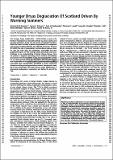| dc.contributor.author | Bromley, Gordon R. M. | |
| dc.contributor.author | Putnam, Aaron E. | |
| dc.contributor.author | Rademaker, Kurt M. | |
| dc.contributor.author | Lowell, Thomas V. | |
| dc.contributor.author | Schaefer, Joerg M. | |
| dc.contributor.author | Hall, Brenda | |
| dc.contributor.author | Winckler, Gisela | |
| dc.contributor.author | Birkel, Sean D. | |
| dc.contributor.author | Borns, Harold W. | |
| dc.date.accessioned | 2019-01-10T12:43:49Z | |
| dc.date.available | 2019-01-10T12:43:49Z | |
| dc.date.issued | 2014-04-14 | |
| dc.identifier.citation | Bromley, Gordon R. M., Putnam, Aaron E., Rademaker, Kurt M., Lowell, Thomas V., Schaefer, Joerg M., Hall, Brenda, Winckler, Gisela, Birkel, Sean D., Borns, Harold W. (2014). Younger Dryas deglaciation of Scotland driven by warming summers. Proceedings of the National Academy of Sciences, 111(17), 6215-6219. doi: 10.1073/pnas.1321122111 | en_IE |
| dc.identifier.issn | 0027-8424 | |
| dc.identifier.issn | 1091-6490 | |
| dc.identifier.uri | http://hdl.handle.net/10379/14777 | |
| dc.description.abstract | The Younger Dryas Stadial (YDS; similar to 12,900-11,600 y ago) in the Northern Hemisphere is classically defined by abrupt cooling and renewed glaciation during the last glacial- interglacial transition. Although this event involved a global reorganization of atmospheric and oceanic circulation [Denton GH, Alley RB, Comer GC, Broecker WS (2005) Quat Sci Rev 24: 1159-1182], the magnitude, seasonality, and geographical footprint of YDS cooling remain unresolved and pose a challenge to our understanding of abrupt climate change. Here, we present a deglacial chronology from Scotland, immediately downwind of the North Atlantic Ocean, indicating that the Scottish ice cap disintegrated during the first half of the YDS. We suggest that stratification of the North Atlantic Ocean resulted in amplified seasonality that, paradoxically, stimulated a severe wintertime climate while promoting warming summers through solar heating of the mixed layer. This latter process drove deglaciation of downwind landmasses to completion well before the end of the YDS. | en_IE |
| dc.description.sponsorship | This research is supported by grants from the Dan and Betty Churchill Exploration Fund and the Lamont–Doherty Earth Observatory (LDEO) Climate Center. G.R.M.B. was supported by a LDEO postdoctoral fellowship. A.E.P. was supported by the Gary Comer Science and Education Foundation, the National Oceanographic and Atmospheric Administration, and a LDEO postdoctoral fellowship. This is LDEO contribution no. 7772. | en_IE |
| dc.format | application/pdf | en_IE |
| dc.language.iso | en | en_IE |
| dc.publisher | National Academy of Sciences | en_IE |
| dc.relation.ispartof | Proceedings Of The National Academy Of Sciences Of The United States Of America | en |
| dc.rights | Attribution-NonCommercial-NoDerivs 3.0 Ireland | |
| dc.rights.uri | https://creativecommons.org/licenses/by-nc-nd/3.0/ie/ | |
| dc.subject | ABRUPT CLIMATE-CHANGE | en_IE |
| dc.subject | EAST GREENLAND IMPLICATIONS | en_IE |
| dc.subject | RADIOCARBON-DATES | en_IE |
| dc.subject | WESTERN NORWAY | en_IE |
| dc.subject | PALEOCLIMATIC IMPLICATIONS | en_IE |
| dc.subject | ENVIRONMENTAL HISTORY | en_IE |
| dc.subject | GLACIER RESPONSE | en_IE |
| dc.subject | POLLEN DIAGRAMS | en_IE |
| dc.subject | CIRQUE GLACIERS | en_IE |
| dc.subject | HEINRICH EVENTS | en_IE |
| dc.title | Younger Dryas deglaciation of Scotland driven by warming summers | en_IE |
| dc.type | Article | en_IE |
| dc.date.updated | 2018-12-27T22:02:18Z | |
| dc.identifier.doi | 10.1073/pnas.1321122111 | |
| dc.local.publishedsource | https://doi.org/10.1073/pnas.1321122111 | en_IE |
| dc.description.peer-reviewed | peer-reviewed | |
| dc.internal.rssid | 13081818 | |
| dc.local.contact | Gordon Bromley, -. - Email: gordon.bromley@nuigalway.ie | |
| dc.local.copyrightchecked | Yes | |
| dc.local.version | ACCEPTED | |
| nui.item.downloads | 313 | |


